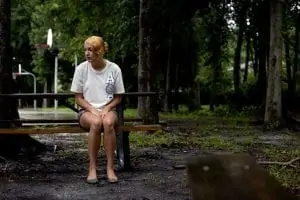The Problem
Hawaii is a hub for international business and trading, with an economy fueled by tourism and a large military populati

Earlier this year, Governor David Ige and Mayor Kirk Caldwell declared a state of emergency as they have been addressing the Hawai’i homeless problem. The problem is ever growing and it is worsening every day. Given the high cost of living, limited land and community housing, low wage paying jobs, the number of homeless individuals and families is on the rise. Children and families are living under tarps, in tents, in cars, under bridges, and in parks with nowhere to go. Homelessness is prevalent on all of the IslandsThere are an estimated 487 homeless in Hawai’i per 100,000 people— the highest rate per capita followed by New York and Nevada according to federal statistics. The correlation between trafficking and homelessness hasn’t received as much attention recently in the media and I would like to highlight the risk that youth face. Being homeless, significantly increases the vulnerability for children to be recruited, conned, and exploited through sex trafficking. Whether being homeless as a family or as an individual homeless/runaway youth —–survival can lead to desperate measures resulting in victimization.
Youth who end up homeless, may be running away to escape physical and sexual abuse and sadly, others have been ordered out of the home by parents who reject them or cannot afford to take care of them. Often disconnected from family and friends, homeless kids are particularly susceptible to traffickers who lure them with the promise of food, warmth, “safety and security” and false love. Once snatched from the streets without anyone noticing, they are sold for the highest price, their dignity and sense of self destroyed. Many factors contribute to the overall number of homeless youth each year, but common reasons are family dysfunction or crisis, exiting the child welfare or juvenile justice systems, and sexual abuse.
The following statistics are mind blowing and put into perspective the scope of the issue facing our state and our country.
The National Runaway Safeline presented the following data on runaway statistics:
These young people often flee abuse and violence at home, but are exposed to further sexual victimization and human trafficking once on the street.
Both locally and nationally, we are facing a growing population of homeless youth who are readily being victimized through commercial sexual exploitation. Housing for homeless families and youth is a growing concern. Homeless youth who have been victimized and sexually exploited suffer from horrible traumas. Often this requires a tailored and intensive intervention with ideal placement being a longer term residential program. Given the complex needs of this population of children, managing and meeting the needs can be difficult for short term placements especially when there is not a home to return to. Sometimes these children enter into the social and juvenile justice systems and these agencies are struggling to find services and referral resources specifically related to the trafficked child and especially services providing residential care and intervention. When children do not receive comprehensive services, they have a tendency to return back to the streets, back to the arms of those who exploit them. Research has proven that this population of children requires a comprehensive setting of care to begin to heal from their trauma. If we do not provide rehabilitative residential care, we are contributing to further victimization of this population of children and we are also increasing the burden on society to care for these children who when they become adults may remain within the cycle of abuse, violence and homelessness of which costs our communities millions of dollars. The greater issue is that the innocence of these children is being stolen and they need hope for the future, opportunity for life changes, and a chance to dream again.
We continue to press forward to make Pearl Haven a reality for youth.
~ Jessica
President/Founder
Sources of Information:
http://www.latimes.com/nation/la-adna-hawaii-homeless-20151115-story.html
http://www.endhomelessness.org/files/2559_file_Sexual_Exploitation_of_Homeless_Youth_10_2009.pdf
Hawaii is a hub for international business and trading, with an economy fueled by tourism and a large military populati
For most people, time spent in community service might be a few weekend hours at a local shelter or fundraiser. But for
We are thrilled to announce another major milestone! Just this summer, Hoʻōla Nā Pua was conditionally approved to st

P.O. Box 22551
Honolulu, HI 96823
[email protected]
(808) 445-3131
This website uses cookies so that we can provide you with the best user experience possible. Cookie information is stored in your browser and performs functions such as recognising you when you return to our website and helping our team to understand which sections of the website you find most interesting and useful.
Strictly Necessary Cookie should be enabled at all times so that we can save your preferences for cookie settings.
If you disable this cookie, we will not be able to save your preferences. This means that every time you visit this website you will need to enable or disable cookies again.
This website uses Google Analytics to collect anonymous information such as the number of visitors to the site, and the most popular pages.
Keeping this cookie enabled helps us to improve our website.
Please enable Strictly Necessary Cookies first so that we can save your preferences!